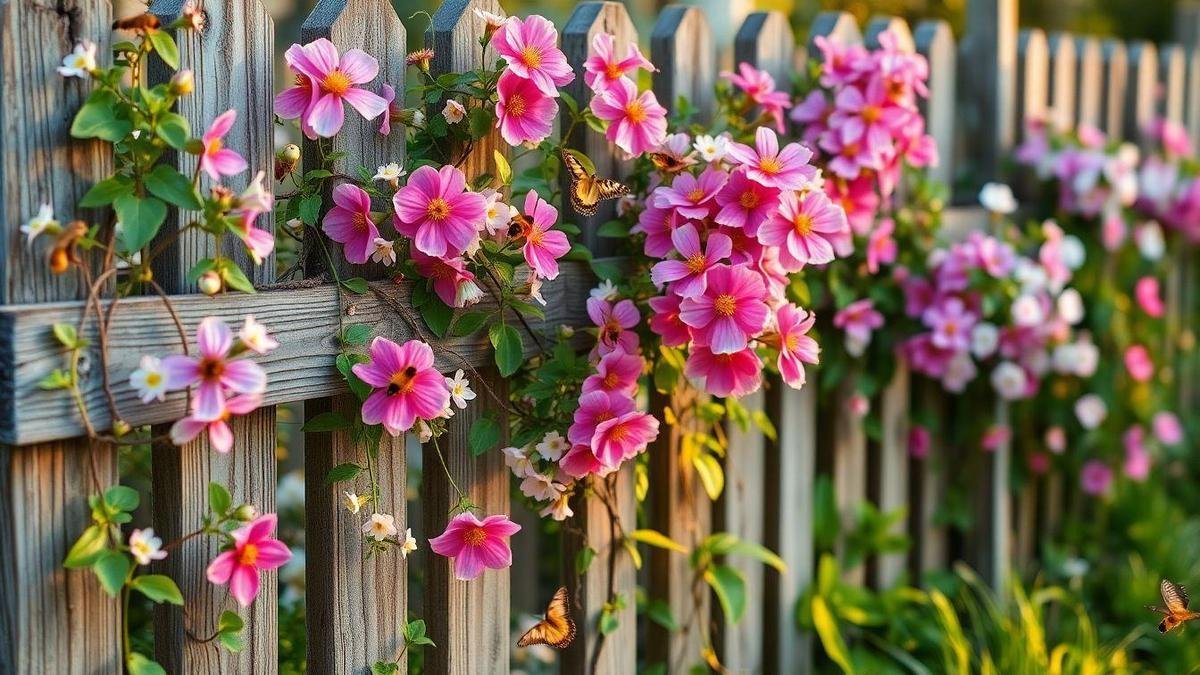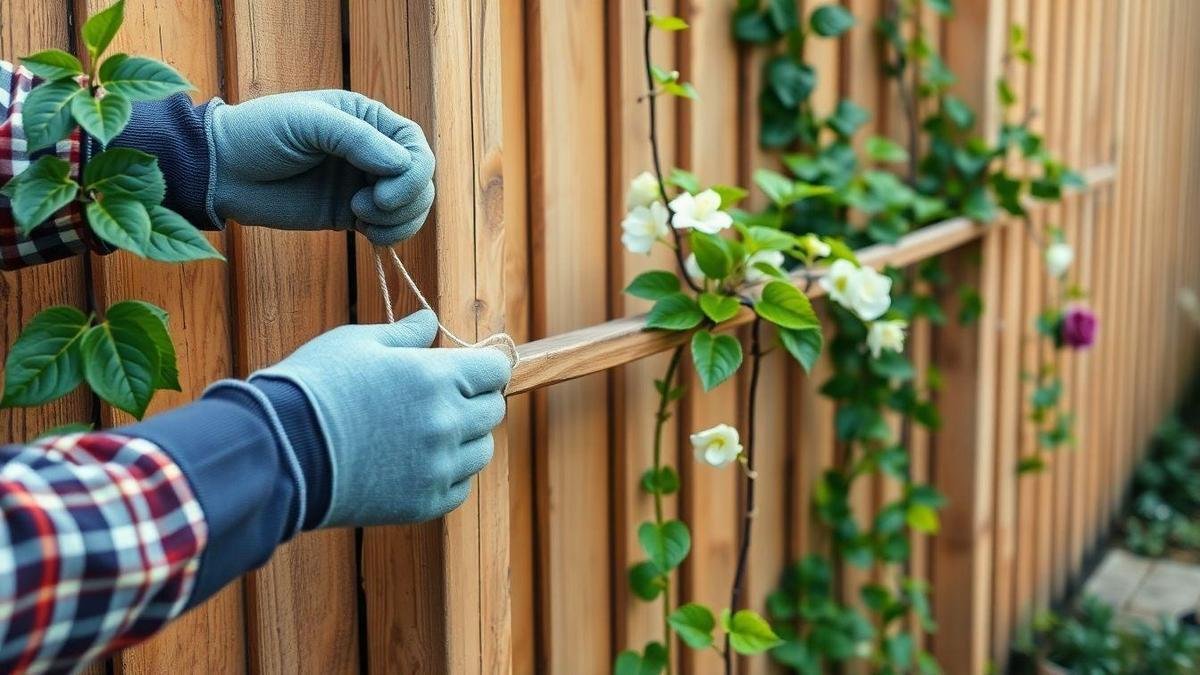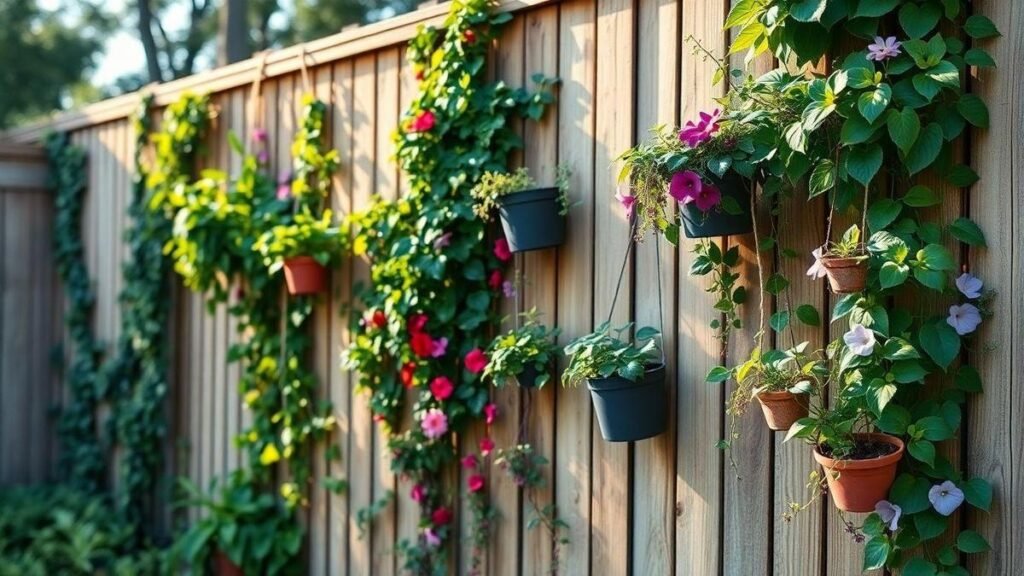Climbing Plants for vertical gardening on fences
Climbing plants for vertical gardening on fences are my secret weapon for turning a boring fence into a leafy fortress. I follow a simple checklist so I don’t end up with a vine that eats the neighbor’s lawn. Before I buy, I always check soil, light, and hardiness. I pick plants for space, support, and purpose — privacy, color, or pollinators. I favor evergreen climbers for year‑round screens, use fast growers for quick cover, and choose native and low maintenance options when I want less work and more naps. I also share how I train, prune, mulch, and secure supports so my fence stays tidy and my plants behave.
Key Takeaway
- Pick climbers that fit your fence and care level.
- Use soft ties to train vines so they don’t go rogue.
- Check fence strength so plants don’t bring it down.
- Prune regularly to avoid a wild jungle on your fence.
- Water at the roots and feed occasionally for happy vines; learn water-wise habits in water-saving tips for home gardeners.

How I choose climbing plants for vertical gardening on fences
I use a short checklist
My brain likes lists. My plants like direction.
- Light — how much sun does the fence get?
- Soil — sandy, clay, or loamy? pH matters.
- Zone — will it survive my winter?
- Space — how wide and tall can it grow?
- Support — can the fence hold a heavy climber?
- Purpose — privacy, flowers, fruit, or scent?
| Item | Why it matters |
|---|---|
| Light | Plants die fast in the wrong light. |
| Soil | Roots fight stubborn dirt — test pH and consider an appropriate mix (see guides on the best soil mix). |
| Zone | Winter kills the wrong guest. |
| Support | Thin fence = no heavy vines. |
| Purpose | Pick the plant that does the job. |
This keeps me from buying every pretty vine at the nursery and then having a fence that looks like a botanical crime scene.
I check soil, light, and hardiness before I buy
I walk to the fence, take a quick soil test, and check my hardiness zone. I note how many hours of direct sun hit the fence.
- Soil: cheap kit for pH and texture.
- Light: four hours = sunny.
- Zone: type ZIP into the USDA map.
Real example: my side fence gets morning sun and afternoon shade, so I picked a part-sun climber and saved a crying plant.
I pick plants based on space, support, and purpose
Measure first. If the gap is 2 ft, don’t pick a 10‑ft spreader. If the fence is thin wood, avoid heavy climbers.
| Plant Example | Light | Support Needed | Best For |
|---|---|---|---|
| Clematis | Part sun | Trellis/wire | Flowers, color |
| Honeysuckle | Sun–part shade | Wire/light trellis | Scent, pollinators |
| Ivy (evergreen) | Shade–part sun | Minimal, can cling | Year‑round cover |
| Climbing Rose | Full sun | Strong posts/wires | Showy flowers, fragrance |
| Morning Glory | Full sun | Light trellis | Fast annual color |
| Kiwi (male female) | Full sun | Sturdy arbor | Edible fruit, big growth |
Match plants to room, fence strength, and your goal: quick privacy, long bloom, or low fuss. If you want to design a full vertical scheme, see tips on making a vertical garden at home.
Why I pick climbers for privacy and screening
I like a green curtain. I choose climbers that hide prying eyes fast and clean, and that look good in both summer and winter.
I prefer evergreen climbers for year‑round screening
I choose evergreen climbers because they keep leaves through cold months. For tidy, leafy walls, I lean on evergreen species that cling or twine well and don’t drop everything in fall.
I compare growth rate and leaf density
Two things matter: growth speed and leaf density. Fast dense = instant privacy; slow textured = classic charm.
| Plant | Growth Rate | Leaf Density | Notes |
|---|---|---|---|
| English Ivy | Fast | High | Clings well; needs control |
| Star Jasmine | Medium | High | Fragrant; evergreen in mild areas |
| Euonymus (wintercreeper) | Fast | High | Great cover; can spread |
| Climbing Hydrangea | Slow | Medium | Thick in summer; loses leaves in cold |
| Clematis montana | Fast | Medium‑High | Quick bloom and cover; seasonal |
I aim for dense cover and manageable choices: evergreen, clings/twines, trims well, not wildly invasive. Train new shoots, prune yearly, and watch runners.
My favorite fast‑growing fence vines (when I need quick cover)
Fast growers give quick cover but need early training and sturdy support.
- Morning glory — instant summer color (annual).
- Trumpet vine — rapid screening; needs strong control.
- English ivy — year‑round cover; control required.
| Support Type | Best For | Pros | Cons |
|---|---|---|---|
| Sturdy Trellis | Heavy, woody climbers | Strong, hides fence | |
| Tensioned Wires | Fast, twining vines | Slim, low‑profile | |
| Light Netting | Annual/gentle climbers | Cheap, easy to move |
Check anchors and screws every season — the frame should outlast the vine.
Prune and monitor vigor
Prune to stop the jungle. Light trims during the season; harder cuts in late winter or after flowering. Compost trimmings or use green bin. Regular pruning keeps the fence neat and the vine healthy — follow recommended pruning techniques for best results.

How I use flowering vines to add color and pollinators
I plant climbers to add color, scent, and steady pollinators. I stagger bloom times: early, mid, and late bloomers so something is always open for bees and butterflies. For choosing the right species to attract visitors, I check lists of the best outdoor plants to attract pollinators and use strategies from creating a pollinator garden.
| Vine Role | Typical Bloom Time | Why I pick it |
|---|---|---|
| Early | Spring | Pollen right after cold ends |
| Mid | Late spring–summer | Bulk of pollinator visits |
| Late | Late summer–fall | Helps late‑season bees |
I favor native climbers from local nurseries — they feed local bees better than many imports. After swapping one non‑local vine for a native climber, I saw more bumblebees in weeks.
Balance showy blooms with leafy climbers: flowers feed pollinators; foliage gives shelter and nesting spots. Leave some seedheads through winter and prune in stages so blooms keep coming without turning the fence into a jungle.
Low‑maintenance and shade‑tolerant climbers for busy gardens
I plant low maintenance climbers when my schedule is tight. They climb fences, mind their own business, and look good without constant fuss.
- Pick self‑clinging or twining types so you don’t tie every tendril.
- Avoid plants demanding daily pruning.
| Plant | Light | Evergreen? | Why I like it |
|---|---|---|---|
| Boston Ivy | Part sun / shade | No | Fast cover, low fuss |
| Virginia Creeper | Sun / part shade | No | Tough, hides posts |
| English Ivy | Shade / part sun | Yes | Year‑round green, climbs anywhere |
For shady fences, choose shade‑tolerant and evergreen climbers; see suggestions for low-light gardens and perennial choices for shady spots.
Mulch 2–3 in to keep roots cool, water deeply and infrequently, and give new plants extra water their first season. Learn how to avoid watering mistakes in how to prevent overwatering and underwatering.

How I train climbers and build supports
I pick a support based on the plant. Simple fixes that last are my rule; for step‑by‑step guidance I follow a training approach that matches the vine to its hardware (training techniques).
| Support | Best for | Why I pick it |
|---|---|---|
| Trellis | Big vines (wisteria, honeysuckle) | Strong, hides fence |
| Wire | Climbers that spread (ivy, clematis) | Low profile, easy to train |
| Clips | New shoots | Gentle, reusable |
- Drill solid anchor points into posts.
- Leave slight slack on wires for stem growth.
- Check fasteners once a season.
Start training young stems: tie loosely with soft ties, guide laterals, and prune small side growth. Early work = less drama later.
Inspect anchors each spring and fall: tighten bolts, re‑tension wires, replace frayed fasteners, and repair rotten wood before it fails. If you want to propagate or replace a section, tips on growing plants from cuttings can help you multiply favorites.
Best climbing plants for vertical gardening on fences — my top picks
Here are reliable options I use often. All are excellent choices for Climbing Plants for vertical gardening on fences.
- Clematis — stunning flowers, best on trellis/wire.
- Honeysuckle — fragrant, attracts pollinators (see pollinator plant lists).
- English Ivy — evergreen, dense cover (control required).
- Star Jasmine — fragrant, good for mild climates.
- Climbing Rose — showy blooms, needs strong support; basic care in growing roses like a pro.
- Virginia Creeper — tough and forgiving for large screens.
- Morning Glory — fast annual color for quick impact (also listed among easy-care flowers for small gardens).
- Climbing Hydrangea — shade tolerant, textured look.
- Euonymus (wintercreeper) — low fuss evergreen cover.
Conclusion
Keep it simple. Use a tight checklist — soil, light, and hardiness — to avoid buying vines that stage a botanical coup. Pick vines for space, support, and purpose: privacy, color for the bees, or low maintenance. Train and tame early: train, prune, mulch, and check your supports so the fence stays neat and the plants don’t start a neighborhood takeover. Short work now saves long headaches — teach your plants manners instead of letting them run the yard like unruly teenagers.
For more tips, triumphs, and a few plant‑related dad jokes, swing by https://myxaro.com.
Frequently asked questions
Q: Which Climbing Plants for vertical gardening on fences work best?
A: Clematis, jasmine, climbing roses, honeysuckle, and hardy ivy are reliable — they climb well, smell great, and cover gaps like a green curtain.
Q: How do I train them up my fence without yelling at plants?
A: Use soft ties, a simple trellis or wire, and gentle nudges. Guide new shoots early and prune the wild ones; see practical methods in training climbing plants for vertical gardens.
Q: Will climbing plants for vertical gardening on fences ruin my fence?
A: Some can. Avoid roots/clings on old wood; leave a gap or barrier to keep wood dry and use supports to protect the fence. Planning a vertical build helps — read how to make a vertical garden at home that preserves structure.
Q: How often do I water and feed these climbers?
A: Water young plants twice a week; once established, water deeply about once a week in dry spells. Feed in spring and mid‑summer. For common watering errors and conservation tips, see preventing over/underwatering and water-saving tips.
Q: Any low‑maintenance climbers for lazy gardeners?
A: English ivy, certain clematis varieties, and wintercreepers are forgiving and require minimal fuss — check the best plants for a low-maintenance garden.






